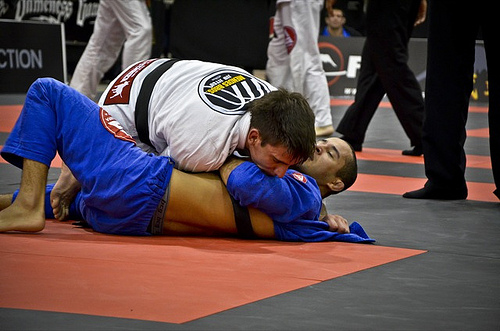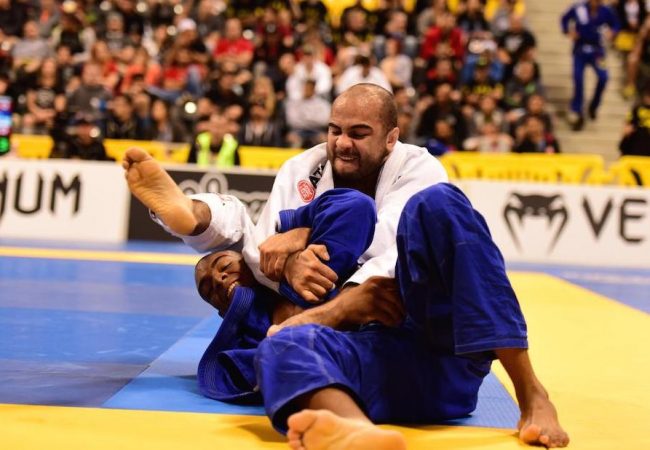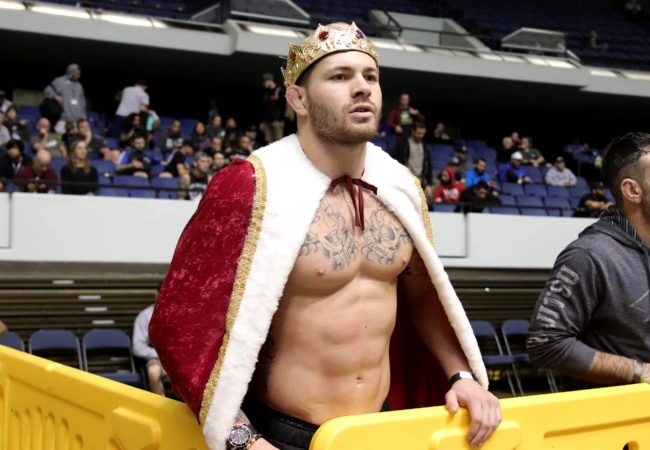The 2011 No Gi Worlds were a big success, with the usual big names coming out to support the event: Marcus “Bochecha” Almeida and Michelle Nicolini of Checkmat, both of whom won gold in the adult black belt absolute and their respective divisions, Rubens “Cobrinha” Charles, Caio Terra, Rafael Lovato, Jr., Roberto “Cyborg” Abreu, Beatriz Mesquita, Lucas Lepri, Roberto “Tussa” Camargo, Emily Wetzel, Antonio Peinado, Victor Estima, and the list goes on and on. They put on a show for the crowd and, judging by the shouting and cheering in the stands, the athletes were definitely successful in their performances on Saturday.
There were other belts who shined as well: brown belt Yuri Simoes of Checkmat pulled off a big open class win against Lloyd Irvin’s ultra heavy Willie Leonard, purple belt Mackenzie Dern won all three of her absolute matches, and 18-year-old Pedro Agrizzi of Striker JJ clinched a big open class win, after only receiving his purple belt two months prior.
This year at the No-Gi Worlds there were 930 competitors registered for this huge one-day event. Those numbers would seem almost impossible to pull off in one day, considering matches can run up to 10 minutes long each in the black belt divisions, but the IBJJF pulled it off flawlessly. Andre Fernandes, Event Director of the IBJJF says he tried to book the Long Beach pyramid for two days, but at this time of year the venue wasn’t available, so they had to run all the competitors through on Saturday. “We could only reserve the pyramid for one day,” Andre says, “This is a busy time of year for other sports, but we are going to try again to book it for two days next year, and we’ll see what happens.”
[flickr set=72157628069046396]
Andre says they have the right team assembled to make this event happen in one day. “Last year we had 800 competitors,” he says, “this year we had 130 more. That’s 15% growth over one year and we still had to turn people away because we reached maximum capacity. We have a mathematician on staff to create the brackets.” Andre is referring to Marcelo Araujo, who seamlessly puts together the brackets so the event runs smoothly in an incredibly organized and efficient manner. In fact, Marcelo has it worked out so well, if a competitor only competes in his weight and not the open, he will be in and out of the event within a couple of hours.
Although the rise of MMA seems to constantly be pushing the No-Gi numbers higher, Andre says at this point, more people still train with the gi than without it. “Our Gi tournaments are still bigger,” he says, “But I hope the two events will eventually even out and that No-Gi will be as big as Gi. You can see here today that the level of competition is really high. That’s what you can expect at a world class event like this.”
At the first No-Gi Worlds, in 2007, Andre says they limited the competitors to a small number to provide organization for the event and to set the standards for what it is today. They wanted to establish a No-Gi Jiu-Jitsu tournament that was consistent with the same high level as their Gi tournaments, so they gave out rash guards with the sleeves the same colors as a competitor’s belts. “We wanted to show everyone the right way to do this kind of event,” Andre says, “Once everyone learned what it was we wanted, we opened up the competition and it has grown every year since. All the numbers are crazy now.”
Andre says the IBJJF invests in their system and it shows with the high quality of tournaments they are able to produce. “We put the money earned from these events back into our future events,” he says, “We have the best mats, the best venue, the best referees. We have more people working the event to keep it organized and running on time. And we send our team around the world to ensure that IBJJF tournaments are run consistently everywhere. We really invest in our events. We put the money back into the sport.”



